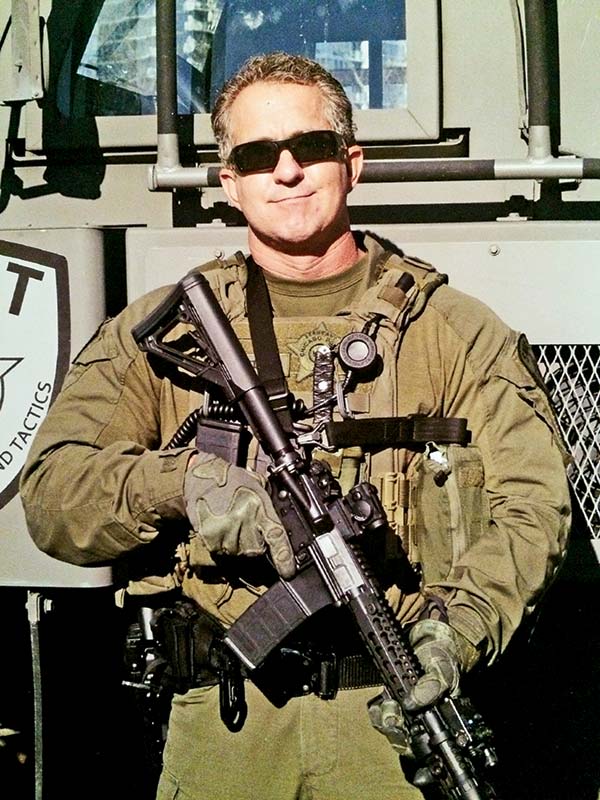Will Competition Get You “Kilt in Da Streetz”?
A Big-City SWAT Cop Says No
Matt Little on Chicago PD SWAT. Matt feels many competition skills do translate to street use for cops.
Sgt. Matt Little has won many “combat pistol” matches, and feels competition is a stone on which to hone real-world survival skills. Matt joined Chicago PD in 1998, has been in SWAT for four years, and SWAT training coordinator for going on two. His 20 years full-time on CPD ran parallel to active reserve military service, including deployment. Matt was in the 20th Special Forces Group, U.S. Army until four years ago. “I was aware how much competitive shooters had influenced the SF community, and it made me curious as to how they trained,” he told American Handgunner.
Chicago has full-time SWAT, 75 operational personnel out of an authorized complement of 13,000 sworn officers. Matt’s role models included (military side) Frank Proctor, “Our instructor in 20th Group,” and Pete Milionis on the police side, the now-retired CPD SWAT cop who once won Steel Challenge, aka the World Speed Shooting Championship, in the IDPA category. Says Matt, “Both told me for years I should shoot in competition. I got into it three years ago. I had known from videos how good top Grandmasters like Leatham were, but I didn’t realize until I got into it just how skilled even B-class competitors could be. I made Master in USPSA in three months. I’ve run 9mm GLOCKs all along, carrying a GLOCK 17 at work and competing with a GLOCK 34.”
Matt quickly recognized some competition techniques didn’t translate well to the street, and vice versa. “I stalled at Master level,” he says. “Some tactical things hold you back: press-out instead of straight to the target draw for example. I had decades of draw and fire practice, but once I had developed an index I could benefit from escalator draw. I still prefer the press-out for street cops, though.”
Reloading on the run at a match, Little knows where competition techniques and street techniques differ.
Competition And Carryovers
However, some things born in shooting competition have already translated well to the notoriously mean streets of Chicago, and were doing so before Matt took on instructor duties. Matt explains, “Milionis and Kenny Ja helped revamp recruit training some time ago. Pete was a Grandmaster in competition and Kenny a Master. Chicago PD’s switch from the Weaver stance to Isosceles and from curled down thumbs to a straight-thumbs grasp came directly from their competition knowledge and has worked well for rank and file officers on the street.”
Competition, Sgt. Little maintains, can provide a nexus between tactics and survival-relevant shooting skills. A lifelong martial artist, he looks at shooting as a martial art. “If all you’ve done is USPSA, you won’t understand tactics, but if all you’ve done is tactics you won’t do it as quickly and as accurately as you can with what you learn from competition,” Little told AH.
For example, he explains, “Transferring efficiency between those two worlds is critical. Tactically, you go to the hard corners first. The old way was sweeping slower than the muzzle of the carbine instead of bringing it directly to those hard corners. The purely tactical world doesn’t address footwork enough, and what you learn about that in action shooting competition can make your tactics work more efficiently. Matches teach you to get to the same tactically advantageous positions sooner and more efficiently.”
Street Results
His instructional duties notwithstanding, Matt is still operational and goes on callouts. His skills served him well a few years ago when, on patrol, a suspect he was chasing turned on him with a gun. Matt was able to put seven fast shots into him before the man could fire. Autopsy showed any of the seven would have been fatal.
The sergeant takes as many classes as he can, often on his own time and dime, balancing shooting with tactics. One of his recent training experiences was studying under Gabe White who was kind enough to introduce us. Matt is now 50, and before competition, he shot about 12,000 to 15,000 rounds per year. This jumped to 25,000 his first year in competition, and presently, pushing for excellence, he was over 40,000 rounds by the end of third quarter 2018. He is sponsored by Gallant Group Bullets, a veteran-owned company.
Matt notes many things now taken for granted in advanced defensive handgun use first emerged in the competition environment. A current example is the red dot “carry optic” pistol sight. He has permission from CPD T&E to test the RMR sight now mounted on his duty G17 as part of a study to determine potential for department approval or perhaps even, at the SWAT level, adoption as standard.
Competition getting you “killed in the streets?” Matt Little is one big-city cop whose considerable street experience indicates the opposite is true.






